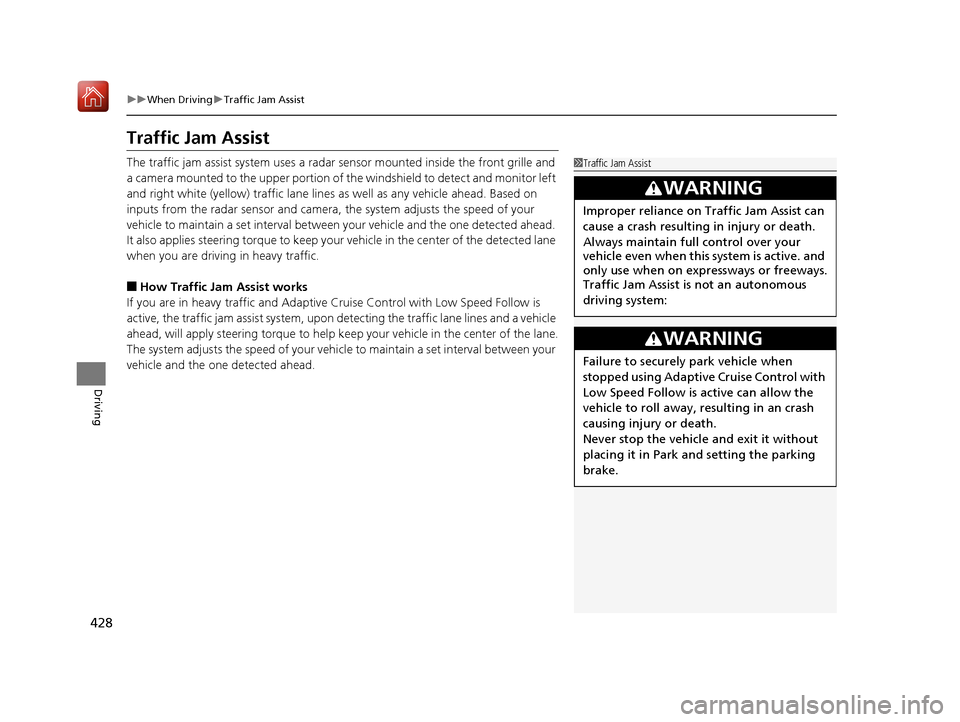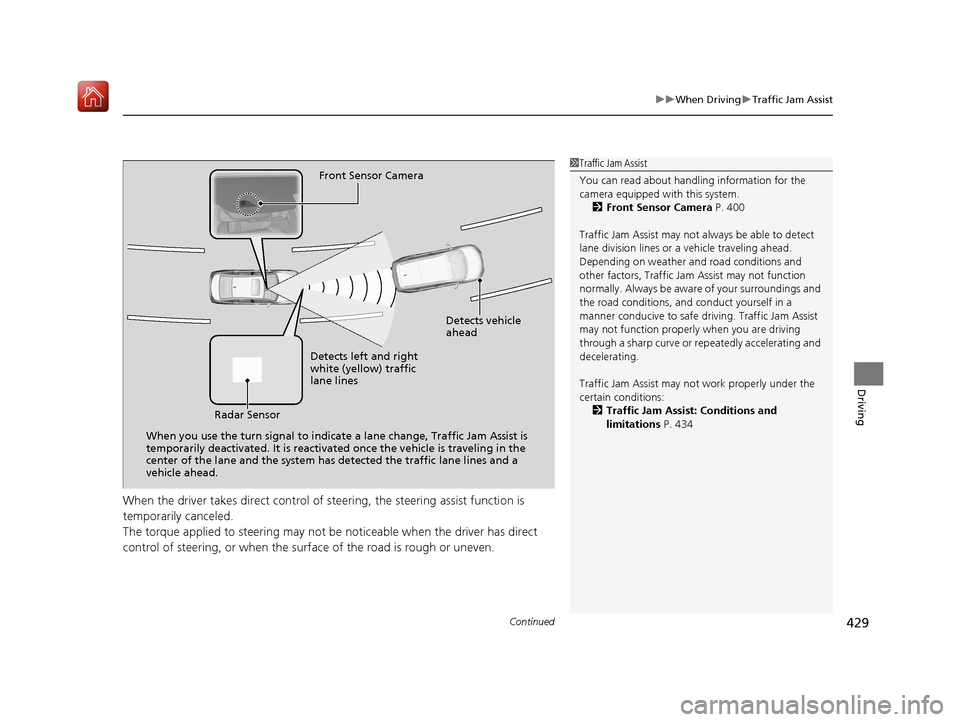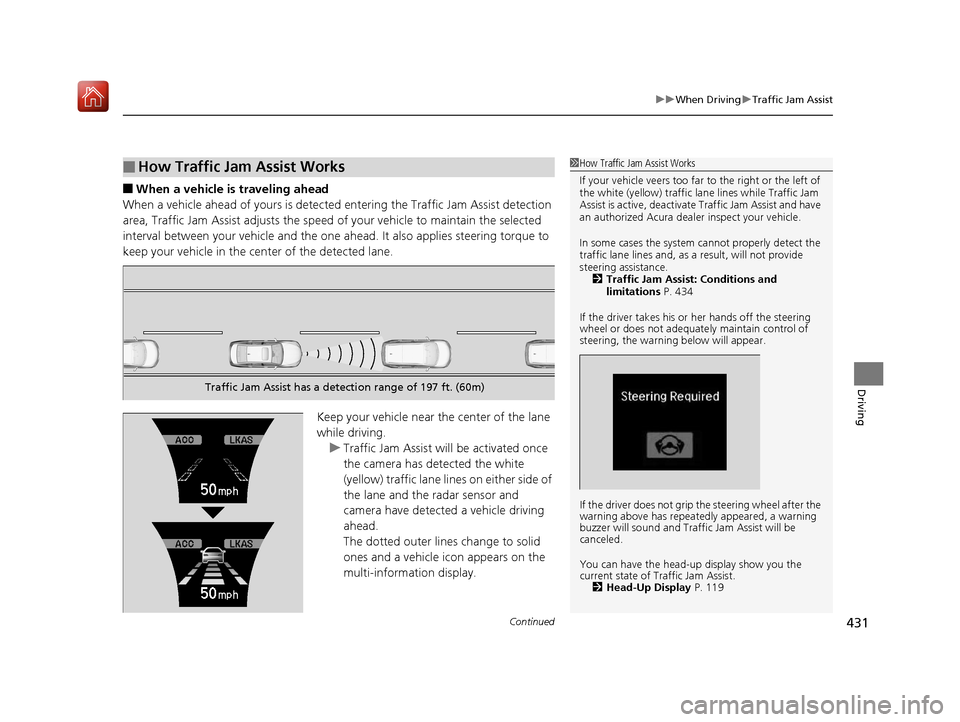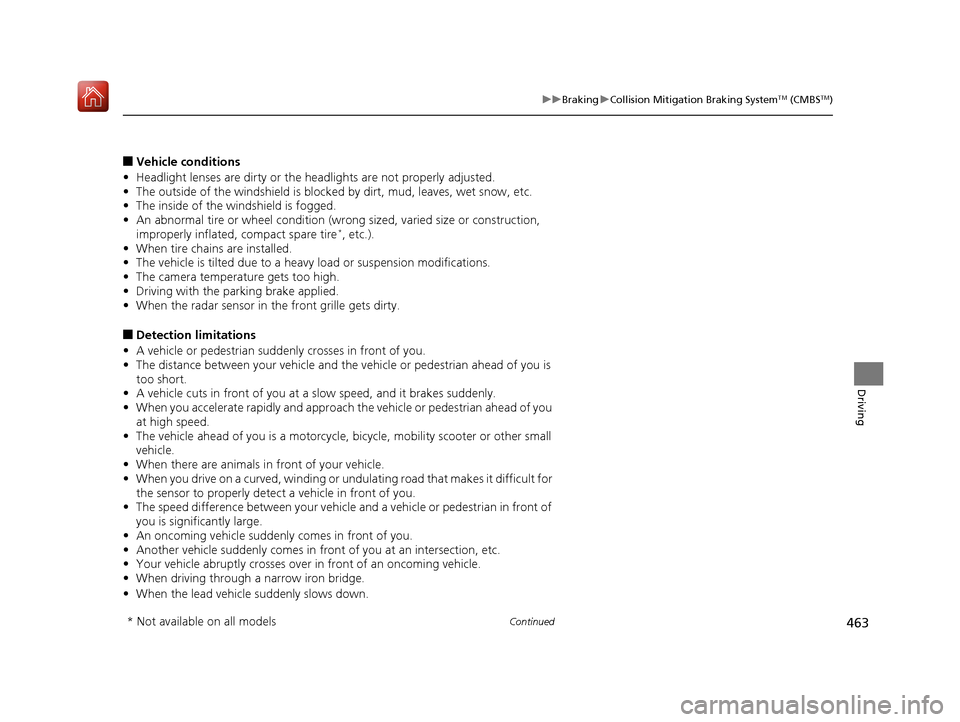sensor Acura RLX HYBRID 2019 Service Manual
[x] Cancel search | Manufacturer: ACURA, Model Year: 2019, Model line: RLX HYBRID, Model: Acura RLX HYBRID 2019Pages: 609, PDF Size: 47.44 MB
Page 429 of 609

428
uuWhen Driving uTraffic Jam Assist
Driving
Traffic Jam Assist
The traffic jam assist system uses a radar sensor mounted inside the front grille and
a camera mounted to the upper portion of the windshield to detect and monitor left
and right white (yellow) traffic lane line s as well as any vehicle ahead. Based on
inputs from the radar sensor and camera, the system adjusts the speed of your
vehicle to maintain a set interval betwee n your vehicle and the one detected ahead.
It also applies steering torque to keep your vehicle in the center of the detected lane
when you are driving in heavy traffic.
■How Traffic Jam Assist works
If you are in heavy traffic and Adaptive Cruise Control with Low Speed Follow is
active, the traffic jam assist system, upon detecting the traffic lane lines and a vehicle
ahead, will apply steering torque to help keep your vehicle in the center of the lane.
The system adjusts the speed of your vehicl e to maintain a set interval between your
vehicle and the one detected ahead.
1 Traffic Jam Assist
3WARNING
Improper reliance on Traffic Jam Assist can
cause a crash resulting in injury or death.
Always maintain full control over your
vehicle even when this system is active. and
only use when on expressways or freeways.
Traffic Jam Assist is not an autonomous
driving system:
3WARNING
Failure to securely park vehicle when
stopped using Adaptive Cruise Control with
Low Speed Follow is active can allow the
vehicle to roll away, resulting in an crash
causing injury or death.
Never stop the vehicle and exit it without
placing it in Park and setting the parking
brake.
19 ACURA RLX HYBRID CSS-31TY36500.book 428 ページ 2018年3月7日 水曜日 午後4時19分
Page 430 of 609

Continued429
uuWhen Driving uTraffic Jam Assist
Driving
When the driver takes direct control of steering, the steering assist function is
temporarily canceled.
The torque applied to steering may not be noticeable when the driver has direct
control of steering, or when the surfa ce of the road is rough or uneven.
Front Sensor Camera
Detects vehicle
ahead
Detects left and right
white (yellow) traffic
lane lines
Radar Sensor
When you use the turn signal to indica te a lane change, Traffic Jam Assist is
temporarily deactivated. It is reactivated once the vehicle is traveling in the
center of the lane and the system has detected the traffic lane lines and a
vehicle ahead.1 Traffic Jam Assist
You can read about handling information for the
camera equipped with this system.
2 Front Sensor Camera P. 400
Traffic Jam Assist may not always be able to detect
lane division lines or a vehicle traveling ahead.
Depending on weather and road conditions and
other factors, Traffic Jam Assist may not function
normally. Always be awar e of your surroundings and
the road conditions, and conduct yourself in a
manner conducive to safe driv ing. Traffic Jam Assist
may not function properly when you are driving
through a sharp curve or re peatedly accelerating and
decelerating.
Traffic Jam Assist may not work properly under the
certain conditions:
2 Traffic Jam Assist: Conditions and
limitations P. 434
19 ACURA RLX HYBRID CSS-31TY36500.book 429 ページ 2018年3月7日 水曜日 午後4時19分
Page 432 of 609

Continued431
uuWhen Driving uTraffic Jam Assist
Driving
■When a vehicle is traveling ahead
When a vehicle ahead of yours is detected entering the Traffic Jam Assist detection
area, Traffic Jam Assist adjusts the speed of your vehicle to maintain the selected
interval between your vehicle and the one ah ead. It also applies steering torque to
keep your vehicle in the ce nter of the detected lane.
Keep your vehicle near the center of the lane
while driving.u Traffic Jam Assist will be activated once
the camera has detected the white
(yellow) traffic lane lines on either side of
the lane and the radar sensor and
camera have detected a vehicle driving
ahead.
The dotted outer lines change to solid
ones and a vehicle icon appears on the
multi-information display.
■How Traffic Jam Assist Works1How Traffic Jam Assist Works
If your vehicle veers too far to the right or the left of
the white (yellow) traffic lane lines while Traffic Jam
Assist is active, deactivate Traffic Jam Assist and have
an authorized Acura deal er inspect your vehicle.
In some cases the system cannot properly detect the
traffic lane lines and, as a result, will not provide
steering assistance. 2 Traffic Jam Assist: Conditions and
limitations P. 434
If the driver takes his or her hands off the steering
wheel or does not adequate ly maintain control of
steering, the warning below will appear.
If the driver does not grip the steering wheel after the
warning above has repeatedly appeared, a warning
buzzer will sound and Traffi c Jam Assist will be
canceled.
You can have the head-up display show you the
current state of Traffic Jam Assist. 2 Head-Up Display P. 119
Traffic Jam Assist has a detection range of 197 ft. (60m)
19 ACURA RLX HYBRID CSS-31TY36500.book 431 ページ 2018年3月7日 水曜日 午後4時19分
Page 438 of 609

437
uuWhen Driving uTraffic Jam Assist
Continued
Driving
• The section of the road branches off or merges with another road.
■Certain features of the road can interfere with proper radar sensor
operation. Here are some examples:
• The road has curves, undulations, slopes, etc.
• The radar beam is reflecting off multiple items that are within close proximity of
your vehicle. This can happen when you are driving, for example, across a narrow
truss bridge.
Lane void of lines at junction
19 ACURA RLX HYBRID CSS-31TY36500.book 437 ページ 2018年3月7日 水曜日 午後4時19分
Page 444 of 609

443
uuWhen Driving uBlind spot information System
Continued
Driving
Blind spot information System
Is designed to detect vehicles in specified alert zones adjacent to your vehicle,
particularly in harder to see areas comm only known as “blind spots.” When the
system detects vehicles approaching from be hind in adjacent lanes, the appropriate
indicator comes on for a few seconds, providing assistance when you change lanes.
■How the system works
1 Blind spot information System
Important Safety Reminder
Like all assistance systems, blind spot information
system has limitations. Over reliance on the blind spot
information system may result in a collision.
The system is for your convenience only. Even if an
object is within the alert zone, the following
situations may occur.
•The blind spot informatio n system alert indicator
may not come on due to obstruction (splashes,
etc.) even without the Blind Spot Info Not
Available multi-information display appearing.
•The blind spot informatio n system alert indicator
may come on even with the message appearing.
The blind spot information system alert indicator may
not come on under the following conditions:
•A vehicle does not stay in the alert zone for more
than two seconds.
•A vehicle is parked in a side lane.•The speed difference between your vehicle and the
vehicle you are passing is greater than 6 mph (10 km/h).
3WARNING
Failure to visually confirm that it is safe to
change lanes before doing so may result in
a crash and serious injury or death.
Do not rely only on the blind spot
information system wh en changing lanes.
Always look in your mi rrors, to either side
of your vehicle, and behind you for other
vehicles before changing lanes.
Alert zone range
A: Approx. 1.6 ft. (0.5 m)
B: Approx. 10 ft. (3 m)
C: Approx. 10 ft. (3 m) Radar Sensors:
underneath the
rear bumper
corners
Alert ZoneA
B
C
●The transmission is in (D.●Your vehicle speed is
between 20 mph (32 km/h)
and 100 mph (160 km/h).
19 ACURA RLX HYBRID CSS-31TY36500.book 443 ページ 2018年3月7日 水曜日 午後4時19分
Page 445 of 609

uuWhen Driving uBlind spot information System
444
Driving
■When the system detects a vehicle
Blind spot information System Alert Indicator:
Located near the outside rearview mirror on
both sides.
Comes on when:
• A vehicle enters the alert zone from behind
to overtake you with a speed difference of
no more than 31 mph (50 km/h) from your
vehicle.
• You pass a vehicle with a speed difference
of no more than 12 mph (20 km/h).
Blinks and a beeper sounds when:
You move the turn signal lever in the direction
of the detected vehicle. The beeper sounds
three times.1 Blind spot information System
•An object not detected by the radar sensors
approaches or passes your vehicle.
•A vehicle running in the adjacent lane is a
motorcycle or other small vehicle.
The system does not operate when in
( R.
You can turn off the audible al ert, or all the blind spot
information system alert using the audio/information
screen. 2 Customized Features P. 295
Blind spot information sy stem may be adversely
affected when:
•Objects (guard rails, poles, trees, etc.) are detected.•An object that does not re flect radio waves well,
such as a motorcycle, is in the alert zone.
•Driving on a curved road.•A vehicle is moving from a far lane to the adjacent
lane.
•The system picks up external electrical interference.
•The rear bumper or the sens ors have been improperly
repaired or the rear bu mper has been deformed.
•The orientation of the sensors has been changed.
•In bad weather (Heavy rain, snow, and fog).
For proper blind spot information system operation:
•Always keep the rear bumper corner area clean.
•Do not cover the rear bumper corner area with
labels or sticke rs of any kind.
•Take your vehicle to a dealer if you need the rear
bumper corner area or the radar sensors to be repaired,
or the rear bumper corner area is strongly impacted.
Comes On
Blinks
19 ACURA RLX HYBRID CSS-31TY36500.book 444 ページ 2018年3月7日 水曜日 午後4時19分
Page 459 of 609

458
uuBraking uCollision Mitigation Braking SystemTM (CMBSTM)
Driving
Collision Mitigati on Braking SystemTM (CMBSTM)
Can assist you when there is a possibility of your vehicle colliding with a vehicle or a
pedestrian detected in front of yours. The CMBSTM is designed to alert you when a
potential collision is determined, as well as to reduce your vehicle speed to help
minimize collision severity when a collision is deemed unavoidable.
■How the system works
1 Collision Mitigation Braking SystemTM (CMBSTM)
Important Safety Reminder
The CMBS
TM is designed to reduce the severity of an
unavoidable collision. It do es not prevent a collision
nor stop the vehicle automati cally. It is still your
responsibility to operate the brake pedal and steering
wheel appropriately acco rding to the driving
conditions.
The CMBS
TM may not activate or may not detect a
vehicle in front of y our vehicle under certain
conditions:
2 CMBS
TM Conditions and Limitations P. 462
You can read about handling information for the
camera equipped with this system. 2 Front Sensor Camera P. 400
Be careful not to have the radar sensor cover strongly
impacted.
1 How the system works
Rapid vibrations on the steering wheel alert you
when your vehicle speed is between 19 and 62 mph
(30 and 100 km/h) with an oncoming vehicle
detected in front of you.
When the CMBS
TM activates, it may automatically
apply the brake. It will be canceled when your vehicle
stops or a potential coll ision is not determined.
The radar sensor is
in the front grille.
The camera is
located behind
the rearview
mirror.
The system starts monitoring the roadway ah ead when your vehicle speed is about 3
mph (5 km/h) and there is a vehicle in front of you.
When to use
The CMBSTM activates when:●The speed difference between your vehicle and a vehicle or pedestrian detected
in front of you becomes about 3 mph (5 km/h) and over with a chance of a
collision.
●Your vehicle speed is about 62 mph (100 km/h) or less and there is a chance of a
collision with an oncoming detected vehicle or a pedestrian in front of you.
19 ACURA RLX HYBRID CSS-31TY36500.book 458 ページ 2018年3月7日 水曜日 午後4時19分
Page 461 of 609

460
uuBraking uCollision Mitigation Braking SystemTM (CMBSTM)
Driving
The system has three alert stages for a possible collision. However, depending on circumstances, the CMBSTM may not go through all of
the stages before initiating the last stage.
■Collision Alert Stages
Distance between vehicles
CMBSTM
The radar sensor detects a vehicleE-pretensioner/
Reactive Force PedalAudible & Visual WARNINGSSteering
WheelBraking
Stage one
There is a risk of a
collision with the
vehicle ahead of
you.
Increases the
accelerator pedal
resistance force.
When in Long, visual and
audible alerts come on at a
longer distance from a vehicle
ahead than in Normal setting,
and in Short, at a shorter
distance than in Normal.
In case of
an
oncoming
vehicle
detected,
rapid
vibration is
provided.
—
Stage
two
The risk of a
collision has
increased, time to
respond is
reduced.Retracts the driver’s
seat belt gently a few
times, providing a
physical warning.
Visual and audible alerts.—
Lightly
applied
Stage
three
The CMBSTM
determines that a
collision is
unavoidable.Forcefully tightens
driver and front
passenger seat belts.
Forcefully
applied
Your Vehicle Vehicle
Ahead
Normal
Short
Long
Accelerator Pedal
Your
Vehicle Vehicle
Ahead
Your
VehicleVehicle
Ahead
19 ACURA RLX HYBRID CSS-31TY36500.book 460 ページ 2018年3月7日 水曜日 午後4時19分
Page 463 of 609

uuBraking uCollision Mitigation Braking SystemTM (CMBSTM)
462
Driving
The system may automatically shut off and the CMBSTM indicator will come on under
certain conditions. Some examples of th ese conditions are listed below. Other
conditions may reduce some of the CMBS
TM functions.
2 Front Sensor Camera P. 400
■Environmental conditions
• Driving in bad weather (rain, fog, snow, etc.).
• Sudden changes between light and dark, such as an entrance or exit of a tunnel.
• There is little contrast between objects and the background.
• Driving into low sunlight (e.g., at dawn or dusk).
• Strong light is reflected onto the roadway.
• Driving in the shadows of trees, buildings, etc.
• Roadway objects or structures are misint erpreted as vehicles and pedestrians.
• Reflections on the interi or of the windshield.
• Driving at night or in a dark condition such as a tunnel.
■Roadway conditions
• Driving on a snowy or wet roadway (obscured lane marking, vehicle tracks,
reflected lights, road spray, high contrast).
• Driving on curvy, winding, or undulating roads.
• The road is hilly or the vehicle is approaching the crest of a hill.
■CMBSTM Conditions and Limitations1CMBSTM Conditions and Limitations
Do not paint, or apply any coverings or paint to the
radar sensor area. This can impact CMBS
TM operation.
Have your vehicle checked by a dealer if you find any
unusual behavior of the system (e.g., the warning
message appears too frequently).
If the front of the vehicle is impacted in any of the
following situations, the ra dar sensor may not work
properly. Have your vehi cle checked by a dealer:
•The vehicle mounted onto a bump, curb, chock,
embankment, etc.
•You drive the vehicle where the water is deep.
•Your vehicle has a frontal collision.
If you need the radar sensor to be repaired, or
removed, or the radar se nsor cover is strongly
impacted, turn off the system by pressing the
CMBS
TM OFF button and take your vehicle to a
dealer.
19 ACURA RLX HYBRID CSS-31TY36500.book 462 ページ 2018年3月7日 水曜日 午後4時19分
Page 464 of 609

463
uuBraking uCollision Mitigation Braking SystemTM (CMBSTM)
Continued
Driving
■Vehicle conditions
• Headlight lenses are dirty or the h eadlights are not properly adjusted.
• The outside of the windshield is blocked by dirt, mud, leaves, wet snow, etc.
• The inside of the windshield is fogged.
• An abnormal tire or wheel condition (wro ng sized, varied size or construction,
improperly inflated, compact spare tire
*, etc.).
• When tire chains are installed.
• The vehicle is tilted due to a heavy load or suspension modifications.
• The camera temperature gets too high.
• Driving with the parking brake applied.
• When the radar sensor in the front grille gets dirty.
■Detection limitations
• A vehicle or pedestrian suddenly crosses in front of you.
• The distance between your vehicle and the vehicle or pedestrian ahead of you is
too short.
• A vehicle cuts in front of you at a slow speed, and it brakes suddenly.
• When you accelerate rapidly and approach the vehicle or pedestrian ahead of you
at high speed.
• The vehicle ahead of you is a motorcycle, bicycle, mobility scooter or other small
vehicle.
• When there are animals in front of your vehicle.
• When you drive on a curved, winding or und ulating road that makes it difficult for
the sensor to properly detect a vehicle in front of you.
• The speed difference between your vehicle an d a vehicle or pedestrian in front of
you is significantly large.
• An oncoming vehicle suddenly comes in front of you.
• Another vehicle suddenly comes in front of you at an intersection, etc.
• Your vehicle abruptly crosses over in front of an oncoming vehicle.
• When driving through a narrow iron bridge.
• When the lead vehicl e suddenly slows down.
* Not available on all models
19 ACURA RLX HYBRID CSS-31TY36500.book 463 ページ 2018年3月7日 水曜日 午後4時19分